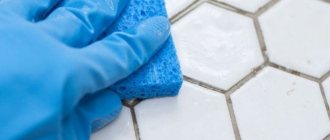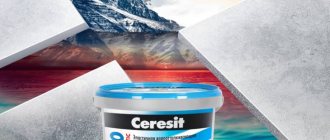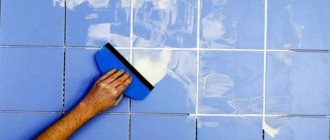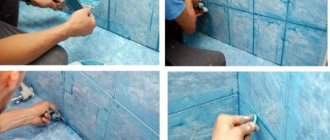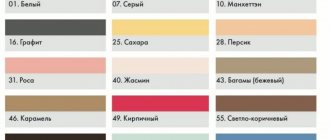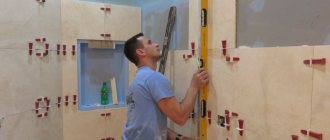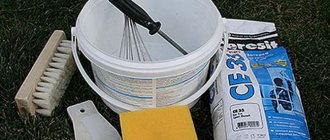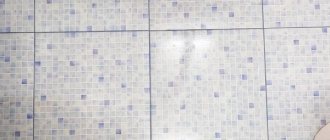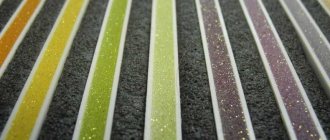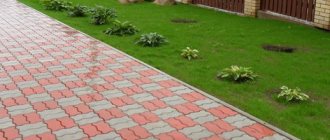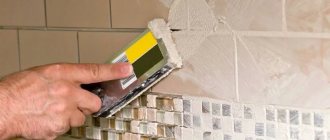Laying ceramic tiles is always a convenient, practical, durable and aesthetic choice. This procedure is not complete without the obligatory step of grouting the joints. The consumable material can be Ceresit grout, which is easy to find in almost any hardware store. It has several types of mixtures that are applicable for a certain type of work. For those who are encountering the tile laying procedure for the first time, this article will be useful. It will help you understand the varieties and purpose of each mixture.
Instructions for grouting tile joints
- You can begin work only after the tile adhesive has completely hardened (see drying time on the packaging). If laying took place on a regular cement-sand mixture, then this period should be at least 7 days.
- The edges of the tiles must be cleaned of any remaining adhesive, grease, or dust. For better adhesion, it is recommended to moisten them with a damp sponge.
- If you are filling in old siding, the old mixture must be completely removed from the joints. They must be equal in depth and width.
- If the tile is not covered with glaze, you need to first test whether the pigments from the grout will color its surface.
Preparing the mixture
- To stir the cement-based dry mixture, it is best to use water at a temperature of 15-20 degrees. Measure out the required amount of water (but do not overdo it, otherwise the technical characteristics of the grout will deteriorate) and while stirring, gradually pour the dry mixture into it. You should get a homogeneous solution without lumps.
- If you are preparing a small amount of the mixture, this can be done manually, but for large volumes it is more convenient to stir it with a drill or a mixer with an attachment at 400-800 rpm.
- After this, it is important to wait 5 minutes for the mixture to ripen and mix it again. You now have 60 minutes to use it.
Applying grout
In order not to stain the embossed tile, it is sealed with a protective film and masking tape.
- Using a rubber spatula, apply the grout to the tiles and spread it over the surface, rubbing it into the joints in a cross motion. Then collect the excess and repeat the operation.
- After 5-10 minutes, the mixture will harden a little, and it will need to be wiped with a damp, clean sponge. But if the sponge is too wet, the color of the seams may then differ.
Wash the grout with a sponge and warm water
We wash away stains after 24 hours with a damp cloth or felt glove.
After removing the protective film, the decor remained clean
Sealing decorative masonry joints:
- Application of the mixture is done using a mounting gun or a cone-shaped bag with a hole. In this case, it is better to start work from the top of the walls and move down.
- After filling the masonry joints, they need to be smoothed with a narrow spatula or rubber jointer. First of all, vertical seams are smoothed, and then horizontal ones.
- The excess is removed with a spatula when the mixture has hardened a little.
- It is recommended to cover the adjacent surfaces to the seam with masking tape.
- A polymer strand must first be inserted into the expansion joints.
- Cut off the tip of the cartridge, leaving a thread, and screw the tip to it. Then you will need to cut off part of the tip so that the size of the hole is equal to the width of the seam.
- Insert the cartridge into the special gun and fill the seam evenly.
- No later than 15 minutes after application, you need to moisten the sealant with soapy water and smooth it with a damp spatula, removing excess. After this, the masking tape can be removed.
- The thickness of the grout should be approximately half the width of the joint.
- If you need to remove fresh silicone grout, you can do this with alcohol or acetone. Hardened - only mechanically.
Colored two-component epoxy grout
Ceresit CE 79 grout consists of two components, which are sold in one package. To prepare the mixture, you need to completely pour the hardener (component B) into the epoxy resin (component A) and mix thoroughly with a mixer at 400 rpm. The mixture can be used within 90 minutes after preparation.
The joints must be filled completely and without gaps using a special spatula for epoxy grout. Using the same spatula, you need to remove excess, using diagonal movements in relation to the seams.
The finished mixture must be loaded into a cartridge for a gun and through a tip with a hole of a suitable diameter, evenly squeeze it into the seams. Excess is removed with an epoxy grout spatula.
If the cladding is used in rooms with high chemical or hydraulic load (swimming pools, garages), the base must first be treated with epoxy waterproofing.
%’>
The finished mixture must be applied to the base using a notched trowel (the size of the teeth is selected depending on the format of the tile).
- Fresh epoxy grout residues can only be removed with a soft and slightly damp sponge. Using circular movements, you must first turn it into an emulsion, and then remove this mass.
- 3-6 hours (but no more) after application, you need to remove the remaining plaque on the tiles with a soft, clean and damp sponge.
- To simplify the cleaning process, you can use special compounds for removing epoxy grout (for example, Litonet, Sopro, Mapei Keraproxy and others).
- The tool must be cleaned with a brush under running warm water. Hardened grout can only be removed mechanically.
- A day after application, you can walk on the epoxy grout, and after a week it will be completely ready for protection from mechanical and chemical loads.
Rules for using grout
After purchasing grout, it is recommended to carefully read the instructions, which will familiarize you with the rules for using the product. If the tiles were laid on a classic sand-cement mortar, then grouting should be done no earlier than 7 days later, when the mortar has dried well. The grouting surface must be dry and clean. The seams should be cleaned of glue or mortar, as well as dust, grease and dirt, which can cause poor-quality grout filling.
If there is old grout between the seams, it must be completely removed and the seams cleaned. Before applying grout, the edges of the tiles should be moistened with a damp sponge. If your tile has a rough, matte structure or an unglazed surface, then before applying grout, you need to test to color the surface of the tile with the pigments contained in the composition. The test is best done on any remaining piece of tile by applying grout to it.
Grout for ceresit tiles should be used under optimal temperature conditions of +5...+20 degrees, for the best adhesion and hardening of the material. If the mixture is dry, then according to the manufacturer's instructions, add a certain amount of water to it, with continuous stirring. If a small amount of grout is needed, you can prepare the solution manually. For large-scale work, it is better to stir the grout with a construction mixer. When stirring, you need to make sure that the mass is homogeneous, without lumps.
After the mixture is mixed, you should take a technological break for 5 minutes, mix again and can be used. It is worth noting that it is recommended to use the finished product within two hours, otherwise its properties will be lost.
When kneading, monitor the level of added water, as its excess will lead to a deterioration in performance. Kneading is not done with metal, rusting tools.
Apply the grout to the seams using a rubber spatula, onto the surface of the tile and carefully rub into the seams. Excess solution is removed with a spatula and the operation is repeated to eliminate all air bubbles. After filling the seam, after 10 minutes, you need to go over the treated surface with a moderately moistened sponge. The grout residue remaining on the tile surface is removed with a dry, soft cloth.
The grout used on floor tiles allows movement on the surface after 8 hours. Contact with water is possible after 24 hours. Over the next five days, the tiles should not come into contact with detergents that could change the color of the grout. Contact only with clean water is allowed.
Ceresit tile grout contains cement and upon contact with water enters an alkaline reaction, so it is recommended to protect the skin of your hands with gloves and prevent the solution from getting into your eyes.
The most popular choice and its nuances: Ceresit tile grout
Reading time: 6 minutes No time?
We will send the material to you by e-mail
If you want to forget about repairs for a long time, use durable and high-quality options for finishing coatings. One of them is ceramic tiles. To make it look perfect on your floors and walls, you need a suitable tile grout. Ceresit is one of the most popular and affordable brands that you will find in any hardware store. In this material from HomeMyHome we will look at the types of this grout and the nuances of its use.
Ceresit is a popular brand among tilers
Application area
The width of the joints that the product can grout varies from 2 to 15 millimeters, this applies to any type of tile. Thus, Ceresit tile grout is used for ceramic, stone, glass tiles, and can be applied to floors and walls.
Due to its high degree of elasticity, it is also used for plasterboard and particle boards that are installed on heated floors. Withstands sudden changes in temperature. It can also be used on the seams of pool tiles.
In general, there are 3 areas of application of the product:
- For narrow joints in the kitchen and bathroom;
- For wide seams where the load is high, i.e. on the floor;
- For seams where resistance to chemicals is needed, it is applicable in laboratories and production facilities.
Due to its high degree of elasticity, it is also used for plasterboard and particle boards that are installed on heated floors.
Range of performance characteristics of Ceresit fugues: all types
Grouts are sold in the form of dry mixtures or ready-made solutions. To improve the quality of seams, coloring pigments and special water-repellent substances are added to them.
The task of grouting is to give the tile masonry a completed look, and in addition, not to allow moisture to penetrate deep into the joints, which can destroy the glue.
The use of grout prevents the formation of fungus, this is especially true for “wet” rooms: bathroom, kitchen, swimming pool and bathhouse. And, of course, grouting makes cleaning much easier: dirt and dust do not accumulate in the seams.
All this will work if the composition of the mixture is chosen correctly. And this is not as simple as it seems at first glance. There are many types of mixtures and each of them is designed for special conditions of application and operation.
It is necessary to take into account not only the composition, but also the color of the grout, its behavior in an aggressive environment
It should be noted that Ceresit brand products have a wide range of choices, so it makes sense to study the most popular formulations and choose the one that suits you.
Ceresit CE 33 Super – 26 shades for the bathroom
This type of mixture is suitable for processing thin joints up to 6 mm wide. It is also chosen because these Ceresit grouts have a rich range of colors, ranging from white to black.
This grout has an innovative formula that prevents the growth of bacteria on the surface and deep in the cladding seams
After hardening, Ceresit CE 33 grout of any color from the palette gives a smooth and even surface that is not afraid of either water or sub-zero temperatures. Resistance to frost allows this model to be used for outdoor work, for example, when finishing the facade with ceramic tiles or imitation stone masonry.
In repair work, it is recommended to combine Ceresit CE 33 tile grout with a silicone analogue for additional treatment of joints in plumbing fixtures.
Related article:
Bathroom tiles: photo, design. A separate publication provides useful information on choosing tiles and properly decorating a bathroom.
Ceresit CE 35 Super – for decorative work with stone
This type of mixture shows excellent results in wide joints up to 15 mm. It is used in laying glass blocks and decorating masonry. Among other things, such grout can be used on cladding with a risk of deformation.
If you add an elasticizer to the composition, Ceresit CE 35 Super will perform well in an outdoor pool
Ceresit CE 43 Super Strong – super strength on wide seams
This mixture can reliably seal a 40mm thick joint, and it's no joke. It also contains antifungal additives and elasticizers that prevent seams from cracking during use.
This composition can be used for work inside and outside, has 9 main colors and is packaged, among other things, in bulk bags of 25 kg
Ceresit CE 40 Aquastatic – not afraid of moisture
The name Aquastatic itself already speaks of the special characteristics of the mixture. The powerful water-repellent formula of Ceresit CE 40 Aquastatic tile grout, complete with antibacterial additives, makes this grout the best choice for swimming pools and saunas. An undoubted advantage of Ceresit CE 40 grout is its palette of 37 colors, including quite unusual ones, like jasmine or latte. Flexible and resilient.
Aquastatic does not crack over time and can withstand extreme temperature changes.
The price of grout for Ceresit tiles per 2 kg package is on average 300-330 rubles.
Ceresit CS 25 – for problematic joints
This flexible silicone-based compound is available in 24 shades, including transparent, and is mainly used for processing complex and problematic seams at corners and in areas adjacent to plumbing fixtures. The undoubted advantage of this model is its resistance to direct sunlight and active chemicals.
Ceresit CS 25 adheres well to glass, porcelain and ceramics
Ceresit CE 79 UltraPox – for aggressive environments
This mixture has a two-component composition based on epoxy resin. Thanks to epoxy, the treated seams will not be afraid of moisture, chemicals, or temperature changes. Ceresit CE 79 UltraPox can be used indoors and outdoors. It is used to process joints of mosaics, stone, ceramics and glass.
The coating is very strong and durable
Related article:
Epoxy grout for tiles : scope and composition, pros and cons, instructions. Review of prices and reviews from real consumers who have used the most popular brands of epoxy grout.
Technical characteristics of Ceresit
They are divided into 3 groups, differing in composition:
- cement mixtures consisting of white or gray cement with the addition of polymers and pigments;
- silicone, used for sealing seams in rooms with high air humidity, consisting of silicone rubber and acetoxysilane (vulcanizing agent);
- solutions based on epoxy resin, a hardener is added to the composition.
Among Ceresit grouts, the most popular are mixtures of cement with mineral fillers and organic modifiers - CE 33 and CE 40.
Ceresit products are of high quality. Grout for tile work is available in the form of a powder and a paste mixture. Has the following properties:
- enhanced antifungal effect;
- large color range;
- good water repellency, can be enhanced by the use of antifungal impregnation of the same brand;
- resistance to dirt and ease of cleaning;
- resistance to deformation - like epoxy grout, it is highly resistant to abrasion;
- good elasticity, which allows the material to be used in different places and for different sizes of seams;
- tolerates frost and temperature changes well, prevents moisture penetration;
- environmental friendliness.
The material from the Ceresit brand has a high degree of hydrophobicity, expressed by the aquastatic effect, which does not allow moisture to penetrate the grout structure and subsequently prevents tiles from falling off in the bathroom and other places with high humidity.
A large number of colors and shades, the possibility of using mixtures for exterior and interior decoration, elasticity of the material, resistance to bacteria and fungi, use for swimming pools, high water-repellent properties when used with silicone grout - these are the advantages of Ceresit mixtures.
Consumers note one drawback - a change in color as the seam dries. This problem is common to mixtures from any manufacturer. To protect yourself and get the desired design solution, you need to choose a moisture-resistant cement grout, focusing on samples of dried joints displayed on the counters.
Pros and cons of grouting joints with Ceresit
If we consider Ceresit products from the point of view of advantages and disadvantages, we get the following picture:
- a large selection of colors, which allows you to choose grout for almost any coating;
- a wide range of compositions for interior and exterior work with different operating modes of surfaces;
- simple algorithm of operation, reliable results, even with the first application experience.
- tiling experts warn that Ceresit mixtures change significantly in color after drying. This effect should be taken into account when selecting shades;
- Some users complain that this mixture contains an unstable pigment that can remain on the rag during cleaning.
How to choose the right Ceresit grout color
40 and 33 mixtures have a large palette of shades, including unusual options that can be matched to different types of tiles.
Usually the shade is selected to match
Even if it is a little darker or lighter, it doesn’t matter. In some finishing options, playing with contrasts is acceptable, this is especially true when finishing with mosaics. If you are using bright tiles with an expressive print, it is wise to limit yourself to a transparent grout that will not distract from the main design.
The color of the mixture can be selected online on the manufacturer’s website. You simply indicate the color of your tile and choose from several suggested options the one you like best.
Remember that when it dries, after a couple of days, the shade will lighten.
Choosing the right color
For repair and finishing work, for which the color of the grout is extremely important, it is worth choosing the main varieties from Ceresit Ce 40 and Ce 33. They provide the widest palette of colors. You can determine the shade of grout for ceresit tiles and the color scheme from the standard set and in other varieties.
In a more complete color spectrum, you can find up to several shades of pink, gray, green, and even unusual colors in the form of caramel, anthracite, and Manhattan.
To create the effect of uniform surface texture, it is necessary to select the shade of Ceresit grout to match the main background of the tile or pattern on it.
To emphasize the division of the surface into individual elements, it is worth considering the contrasting shade of Ceresit grout. If mosaic is used as decor for a bathroom, toilet or kitchen, you can choose either a transparent mixture to emphasize the depth of shades, or choose grout of different colors to add abstractness to the composition or make it geometric.
The manufacturer's official website allows you to select the desired grout online. To do this, you need to specify the color of the tile and select the one you like best from the options offered by the system. It is important to know that the selected shade of grout may differ from the color of the dry substance, as well as that indicated on the packaging or on advertising samples. Ceresite grout does not acquire the selected shade immediately, but after 1-2 days, depending on environmental conditions, and after all recommended actions have been completed.
How to calculate grout consumption for Ceresit tiles per 1 m² of coverage
The consumption of the mixture is indicated on each package of Ceresit grout. This greatly simplifies the calculation task, especially for beginners. If you want to calculate using the formula, you need to add the length and width of the surface, then divide the sum by the product of these indicators. The result obtained should be multiplied by the width and thickness of the seam. The result will be the mixture consumption in kilograms per square meter.
But if you don’t go into such complex calculations, just take the manufacturer’s data as a basis: CE 33 and 40 – 500 g/m², CE 35 – 1200 g/m², CE 79 – 1300 g/m², CE 43 – 1500 g/m². These are the maximum possible values, they may vary depending on the depth and thickness of the seams.
Price
The cost of CE 33 grout varies from 145 to 300 rubles depending on the packaging (2-5 kg). There is also a 25 kg package, the cost of which is 1,545 rubles. But what is the price of Ceresit Se 40 grout and where it can and should be used, is described in the contents of this article. What reviews exist about Diamant epoxy grout and how positive they are is described in great detail in the article. But this information will help you understand what color grout for natural stone is and how to use it correctly. What is the consumption of grouting ceramic tiles and how to correctly set the required quantity is described in great detail in this article. And here’s what grout for Prospector tiles looks like. you can look at the photo.
Practice of using Ceresit tile grout for bathrooms and other rooms
When working with Ceresit grout, you should adhere to the general rules:
- do not rub the seams until the tile adhesive has completely hardened;
- clean the edges of the tiles and lightly moisten them for better adhesion;
- remove remnants of the old mixture during repair work;
- on tiles without glaze, check the pigment to ensure it does not leave streaks;
- Use water at room temperature to mix the dry mixture. The mixture should be poured into water, and not vice versa;
- Before applying the mixture, it should be allowed to stand for 5-7 minutes to mature, and the composition should be used within an hour.
It is better to knead a small volume of the mixture by hand, and for global work use a construction mixer
Cement grout for Ceresit tiles: how to apply
The mixture is kneaded using the technology described above and applied with rubber spatulas, rubbing it into the grooves of the seams. The excess is removed with the same spatula. After application, you need to leave the grout to harden for about 10-15 minutes. After this, the seams are wiped with a wrung-out damp sponge. Do not use a wet sponge; water will partially dissolve the pigment and the seams will be uneven in color.
How long will it take for Ceresit tile grout to dry indoors?
After a day, dried stains can be easily removed with a dry cloth.
Features of applying epoxy grout Ceresit
The epoxy mixture should be mixed strictly according to the instructions. Any deviations can lead to irreparable consequences. The procedure begins by mixing the catalyst and paste.
The composition must be thoroughly mixed and, only after this, powder color can be added.
When grouting tile joints with epoxy Ceresite, you should remember that the composition hardens very quickly, so you need to work quickly and carefully. All excess must be removed from the surface immediately.
How to apply Ceresit silicone grout
Silicone grout is not recommended for use in contact with metals susceptible to corrosion and mirror tiles. The acetic acid in its composition can have a detrimental effect on such a surface.
It should also be remembered that this material does not stick to rubber, Teflon and polyethylene surfaces
Otherwise, the silicone composition requires the same thorough cleaning of the base from traces of old material and dirt. The seams are first filled with polyethylene foam cord and then rubbed with a silicone mixture. Until the composition hardens, you need to cover the surface from dust and dirt.
Hydrophobic impregnations for tiles and grout
Ceresit CT 10 Super is an impregnation that will reliably protect unglazed tiles and grout from the development of bacterial plaque and fungus. In addition, tiles treated with this impregnation do not get dirty from grease and dirt, and they do not absorb water.
The water repellent is based on silicone. This is a completely safe composition for humans. It can be used outdoors and indoors.
The composition is colorless and odorless, does not change the original color after processing
The impregnation consumption is very small - only about 1 glass per 1 m². Drying time – up to 6 hours depending on the ambient temperature. The water repellent is applied with a brush or spray to cleaned surfaces. On large surfaces, application by pouring is acceptable.
Tile grout Ceresit: issue price
The cost of the material may vary from store to store, but average prices as of March 2022 are as follows:
| Image | Blend name | Packaging, kg | Average cost (as of March 2022, rub. |
| Ceresit CE 33 Super | 5 | 306 | |
| Ceresit CE 35 Super | 5 | 375 | |
| Ceresit CE 43 Super Strong | 2 | 299 | |
| Ceresit CE 40 Aquastatic | 2 | 310 | |
| Ceresit CS 25 | 2 | 117 | |
| Ceresit CE 79 UltraPox | 5 | 3700 |
Types of grout
Ceresit grouts for joints are produced in the following types:
- CE 33 Super – designed to close seams up to six millimeters. The coating is resistant to water and low temperatures, so it is often chosen for outdoor use. The palette of shades is wide; CE 33 Super – designed to close seams up to six millimeters.
- CE 35 Super – designed for joints from 4 to 15 mm. Typically used for grouting joints between glass and stone blocks. And it performs well on surfaces that may be subject to deformation; CE 35 Super – designed for joints from 4 to 15 mm.
- CE 43 Super Strong - characterized by strength and a high degree of elasticity, seam thickness varies from 5 to 40 millimeters. The composition contains antifungal components and plasticizers that prevent the seams from cracking; CE 43 Super Strong – characterized by strength and a high degree of elasticity.
- CE 40 Aquastatic - also has a high degree of elasticity, but the seams should be no more than 10 mm. It is highly resistant to moisture and is supplemented with antifungal elements. Therefore, it is often used to seal joints between tiles in swimming pools and saunas; It is highly resistant to moisture and is supplemented with antifungal elements.
- CE 79 UltraPox - the composition uses two elements, and it is resistant to chemical attack. The composition uses epoxy resin, which creates a reliable layer from exposure to moisture, chemicals and sudden temperature changes. Applicable for both external and internal work; CE 79 UltraPox - the composition uses two elements, and it is resistant to chemical attack.
- CS 25 is the main component of silicone grout, it has the additional property of a sealant, it is excellent for renovation work in the bathroom, and can be conveniently applied between the sink, the bathtub itself and the tile covering. Typically used for corner areas. Resistant to sunlight and chemicals. CS 25 is the main component of silicone grout; it has the additional property of a sealant.
What reviews say about Ceresit grout
It would be dishonest to keep silent about the fact that reviews of Ceresit grout are not always enthusiastic and satisfied. Before deciding to use it, read the opinions of practitioners. In most cases, complaints about the material are related to the mistakes of the masters themselves, usually beginners. Incorrect proportions or errors in the application order can all lead to the mixture crumbling and staining surfaces. This is why it is so important to follow the instructions on the package. In conclusion, we invite you to watch a useful video on applying grout. If you have any questions or are ready to share your own experience, write in the comments!
Which grout is better - Atlas or Ceresit?
The decorative and protective properties of facing tiles determine their consistently high consumer demand. The appearance and durability of tile cladding depends on the correct choice of grout.
The range includes budgetary dry mixes based on cement and gypsum, as well as advanced grouts - epoxy. Their cost is compensated by perfect performance characteristics.
Why shouldn't you save on grout?
- Cheap grouts contain improving latex components: however, the technology involves applying a moisture-resistant varnish coating.
- Moisture-freeze resistant epoxy compounds are initially ready for application and are easy to work with. Therefore, when sealing seams with your own hands, the quality of the work performed is close to a professional level.
The market offers a fairly wide selection of foreign masonry and finishing materials that differ in cost, installation and performance properties.
It is possible to buy masonry mortar: consumption per 1 m3 of masonry is 20% less, achieved by precise dosage of improving additives.
In the category of finishing materials, Polish grout Atlas and a wide range of German grout Ceresit are in stable demand. GOST determines the compliance of these materials with the requirements of modern finishing technologies.
Grout Atlas: advantages and disadvantages
- Polish Atlas grout is characterized by increased elasticity, which significantly increases the resistance of the tile cladding to temperature changes.
- The material has no significant restrictions on external and internal use; a wide color spectrum simplifies the selection of silicone sealants, strips and other related materials.
The practice of using Atlas grout has also revealed significant shortcomings. This is a relatively short time before the start of hardening, a change in the characteristics of the dry mixture during long-term storage in unfavorable conditions, a change in the color of the joints under the influence of moisture and solar ultraviolet radiation.
Different types of polish grout are designed for sealing joints of different widths. Therefore, before purchasing the material, you must read the contents of the attached instructions for use. The cost of a standard Atlas grout material is between 60-70 rubles, in the color version the price varies from 80 to 100 rubles. More advanced epoxy-based materials go on sale at prices up to 500 rubles per kilogram.
Ceresit CS 25
Ceresit CS 25 can serve as an excellent sealant and be used for processing joints in corners. Ceresit colored silicone sealant has the following properties:
- Prevention of fungal infections.
- The one-component substance comes in 24 shades, including transparent.
- Good weather resistance, not afraid of exposure to ultraviolet influences and ozone.
The instructions for use and operation say that the ceresit grout mixture is used for problematic and butt joints, corner seams, as well as places where plumbing fixtures are attached. High level of adhesion to glass, enamel, earthenware and porcelain surfaces. But at the same time, there is no adhesion of the substance to polyethylene, Teflon, rubber, bitumen, as well as materials that emit solvents and oils.
What advantages are typical for Ceresit grouting compounds?
The list of popular grouts is led by products known on the domestic market under the Ceresit brand.
Many materials are produced in Russia, which has a positive effect on their cost.
- The demand for this group of finishing materials is determined by the combination of affordable cost and perfect performance characteristics. The price of Ceresit brand epoxy grout is consistently maintained at 320-350 rubles per kilogram, which allows large-scale finishing work to be performed at lower costs.
- Ceresit grout is in demand in private construction: the color range of this material includes more than three dozen primary colors and 57 additional ones.
- The list of positive properties of Ceresit grout includes hydrophobicity, resistance to mold formation and elasticity, which allows the use of tile coverings under large temperature changes.
Video: how to apply Ceresit CE 40 grout correctly
Attention!
Ceresit grouts differ from similar compounds in their versatility, excellent light fastness, durability, and full compliance with current environmental standards. The material can be used without consequences for sealing joints up to 10 mm wide.
Judging by the reviews on construction sites, both materials are characterized positively, but the majority of buyers prefer Ceresit products. The versatility of the grout, light fastness and the ability to do the finishing yourself are more appreciated.
We are official dealers of the Ceresit company, therefore we offer you dealer prices for the entire range of grouts of this brand! Hurry up to place your order!
Ceresit CT 10 Super
Ceresit st10 super contains silicone and provides protection against moisture, the spread of fungus and dirt. Has the following properties:
- Protects tiles from the accumulation of dirt, water and fungus formation. This is ensured by the micro-protect innovation.
- Available in a transparent form, without reflections or reflections, it is absolutely invisible on the surface.
- There are no solvents in the composition, environmental safety.
You can use sealant for indoor and outdoor work. This Ceresit grout can be used to process tile joints, including those made of stone and unglazed materials. Ideally compatible with all types of rooms that are exposed to moisture.
The manufacturer Ceresit has an assortment of suitable material for any purpose, volume and type of repair. In our assortment you can find materials that will help make any seams and joints beautiful, strong and durable.
